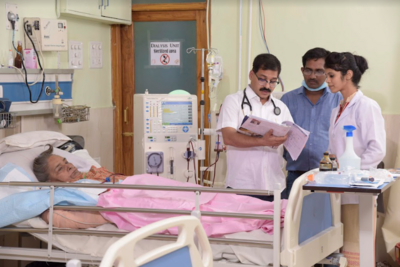End Of Life
Original Editor - Lucinda hampton
Top Contributors - Lucinda hampton
Introduction[edit | edit source]
In today's world many of us will live for several years with a terminal condition. It is of upmost importance to understand when the time has come to discuss the end-of-life (EOL) and how. Studies have highlighted that talking about and planning the EOL plays a crucial role in determining how the final days in a patient’s life pan-out and improves the quality of care they receive at this finale.[1]
Definition[edit | edit source]
End-of-life care encompasses physical, spiritual and psychosocial assessment, care and treatment provided by health professionals and associated staff. Those ‘approaching the end of life’ are people who are potentially going to die within the next 12 months. In this group is included people whose: death is imminent (expected within a few hours or days); those with advanced, progressive, incurable conditions; general frailty and co-existing conditions that mean that they are expected to die within 12 months; existing conditions when a there is a risk of dying from a sudden acute crisis in their condition; and life-threatening acute conditions caused by sudden dire events.[2]
Communication[edit | edit source]
Meaningful communication between people with life-limiting illnesses and their physiotherapist/health care professionals is vital in order to achieve a positive end-of-life experiences for the older person and their loved ones.
The majority of older people have a desire a willingness to talk about the end of life, and hold honest clear communication on the topic in high regard. Note that cultural differences may also be a factor here in relation to the level and type of information people will want to receive.
What is clear is that sensitive, responsive communication about what how the end of life will transpire potentially increases the chance that they receive high-quality palliative care and in the manner that they wish. Family's too gain better satisfaction with open and patient-centred end-of-life discussions.[3]
Shortcomings[edit | edit source]
Research reveals that a great need for individualised conversation tools that are inclusive, ensuring include that every patient is given the opportunity to talk about the EOL in a multitude of setting. Following the provision of conversation tools, health professionals require training on ways to initiate and facilitate EOL discussions. This is a vital point for quality EOL discussions to occur.[1]
Viewing and Resources[edit | edit source]
In the below a nurse describes the common changes that you might notice in someone’s last weeks, days and hours of life.
An educational read for physiotherapists working in acute hospitals and dealing with EOL care: Australian Physiotherapy Association – SA Branch 23 November 2021 End of Life Care Opportunities
References[edit | edit source]
- ↑ 1.0 1.1 Bergenholtz H, Missel M, Timm H. Talking about death and dying in a hospital setting-a qualitative study of the wishes for end-of-life conversations from the perspective of patients and spouses. BMC palliative care. 2020 Dec;19(1):1-9.Available:https://www.ncbi.nlm.nih.gov/pmc/articles/PMC7607873/ (accessed 11.12.2023)
- ↑ Australian Government End of life care Available:https://www.aihw.gov.au/getmedia/68ed1246-886e-43ff-af35-d52db9a9600c/ah16-6-18-end-of-life-care.pdf.aspx (accessed 12.12.2023)
- ↑ ARIIA Knowledge and Implementation Hub. Communication at End of Life: Palliative care and end-of-life evidence themes [Internet]. 2022 [updated 2023 Sep 20; cited 2023 Dec 11]. Available:https://www.ariia.org.au/knowledge-implementation-hub/palliative-care-and-end-of-life/palliative-care-and-end-life-evidence-themes/communication-end-life (accessed 11.12.2023)
- ↑ Marie Curie. What to expect at the end of life. Available from: https://www.youtube.com/watch?v=slNShkHNNpw [last accessed 12/12/2023]







